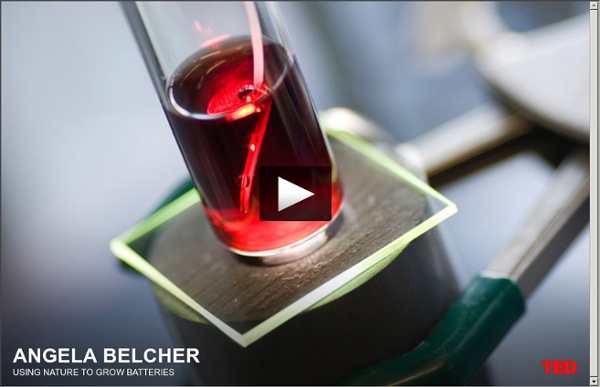



http://www.ted.com/talks/angela_belcher_using_nature_to_grow_batteries.html
Bacteria power 'bio-battery' breakthrough 25 March 2013Last updated at 16:41 ET The shewanella bacterium is found in lakes and rivers all over the planet Bacteria could soon be acting as microscopic "bio-batteries" thanks to a joint UK-US research effort. The team of scientists has laid bare the power-generating mechanism used by well-known marine bacteria. Before now it was not clear whether the bacteria directly conducted an electrical charge themselves or used something else to do it.
Vanadium: The metal that may soon be powering your neighbourhood 13 June 2014Last updated at 19:24 ET By Laurence Knight BBC World Service Hawaii has a problem, one that the whole world is likely to face in the next 10 years. And the solution could be a metal that you've probably never heard of - vanadium. Hawaii's problem is too much sunshine - or rather, too much solar power feeding into its electricity grid. Generating electricity in the remote US state has always been painful.
Hemp fibres 'better than graphene' The waste fibres from hemp crops can be transformed into high-performance energy storage devices, scientists say. They "cooked" cannabis bark into carbon nanosheets and built supercapacitors "on a par with or better than graphene" - the industry gold standard. Electric cars and power tools could harness this hemp technology, the US researchers say. Aluminum battery from Stanford offers safe alternative to conventional batteries Go to the web site to view the video. Mark Shwartz Stanford University Professor Hongjie Dai and colleagues have developed a high-performance aluminum battery. Stanford University scientists have invented the first high-performance aluminum battery that’s fast-charging, long-lasting and inexpensive. Researchers say the new technology offers a safe alternative to many commercial batteries in wide use today.
Scientists Develop a Better Graphene Battery In Brief A collaboration between Graphenano and its Chinese partner Chint has led to a graphene battery that surpasses any current lithium ion battery, and it could soon replace batteries in domestic use and electric cars. POWERING The Future The Spanish company Graphenano has introduced a graphene polymer battery that could allow electric vehicles to have a maximum range of a staggering 800 kilometers (497 miles). Future batteries, coming soon: Charge in seconds, last months and power over the air While smartphones, smarthomes and even smart wearables are growing ever more advanced, they're still limited by power. The battery hasn't advanced in decades. But we're on the verge of a power revolution. Big technology and car companies tare all too aware of the limitations of lithium-ion batteries. While chips and operating systems are becoming more efficient to save power we're still only looking at a day or two of use on a smartphone before having to recharge.
Battery Energy Density Trend - Tesla (seekingalpha) This slide that highlights past and anticipated future battery energy density gains has been a cornerstone of Tesla (TSLA) CTO J.B. Straubel’s presentations for over a decade. Last fall Mr. Straubel was quoted by InsideEVs saying: “These batteries are steadily improving every single year – maybe around 5% improvement in their energy density their ability to store energy in a given amount of mass.